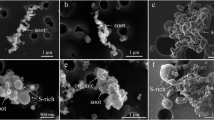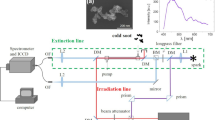Abstract
New data on the dependence of the function of the refractive index of soot particles on their average size in the visible and near-IR spectral regions are presented. The data are obtained by laser-induced incandescence. The sunlight absorption by soot aerosols is currently calculated with a value of the refractive index function of about 0.2 at a wavelength of 550 nm regardless of the origin of soot particles and their variability. The data demonstrate that optical properties of soot depend on the size of particles and conditions of their formation, which, in turn, is related to the degree of their graphitization. It is shown that taking into account the particle size distribution in soot aerosols can lead to an increase in solar radiation absorption by them approximately by two times as compared to the commonly accepted values.


Similar content being viewed by others
REFERENCES
T. C. Bond, S. J. Doherty, D. W. Fahey, P. M. Forster, T. Berntsen, B. J. DeAngelo, M. G. Flanner, S. Ghan, B. Karcher, D. Koch, S. Kinne, Y. Kondo, P. K. Quinn, M. C. Sarofim, M. G. Schultz, M. Schulz, C. Venkataraman, H. Zhang, S. Zhang, N. Bellouin, S. K. Guttikunda, P. K. Hopke, M. Z. Jacobson, J. W. Kaiser, Z. Klimont, U. Lohmann, J. P. Schwarz, D. Shindell, T. Storelvmo, S. G. Warren, and C. S. Zender, “Bounding the role of black carbon in the climate system: A scientific assessment,” J. Geophys. Res.: Atmos. 118, 5380–5552 (2013).
P. Chylek, V. Ramaswamy, and V. Srivastava, “Albedo of soot-contaminated snow,” J. Geophys. Res. 88 (C15), 10837–10843 (1983).
A. S. Ginzburg, D. P. Gubanova, and V. M. Minashkin, “Influence of natural and anthropogenic aerosols on global and regional climate,” Russ. J. Gen. Chem. 79, 2062–2070 (2009).
C. Schulz, B. F. Kock, M. Hofmann, H. A. Michelsen, S. Will, B. Bougie, R. Suntz, and G. Smallwood, “Laser-induced incandescence: Recent trends and current questions,” Appl. Phys. B 83, 333–354 (2006).
E. V. Gurentsov, A. V. Eremin, and E. Yu. Mikheeva, “Study of thermodynamic properties of carbon nanoparticles by the laser heating method,” High Temperature 55 (5), 723–730 (2017).
E. Gurentsov, “A review on determining the refractive index function, thermal accommodation coefficient and evaporation temperature of light absorbing nanoparticles suspended in gas the phase using the laser-induced incandescence,” Nanotechnol. Rev. 7, 583–604 (2018).
D. R. Snelling, F. Liu, and G. J. Smallwood, “Determination of the soot absorption function and thermal accommodation coefficient using low-fluence LII in a laminar coflow ethylene diffusion flame,” Combust. Flame 136, 180–190 (2004).
D. Snelling, K. Thomson, F. Liu, and G. Smallwood, “Comparison of LII derived soot temperature measurements with LII model predictions for soot in a laminar diffusion flame,” Appl. Phys. B 96, 657–669 (2009).
H. Bladh, J. Johnsson, N.-E. Olofsson, A. Bohlin, and P.-E. Bengtsson, “Optical soot characterization using two-color laser-induced incandescence (2C-LII) in the soot growth region of a premixed flat flame,” Proc. Combust. Inst. 33, 641–648 (2011).
N.-E. Olofsson, J. Simonsson, S. Torok, H. Bladh, and P.-E. Bengtsson, “Evolution of properties for aging soot in premixed flat flames studied by laser-induced incandescence and elastic light scattering,” Appl. Phys. B 119, 669–683 (2015).
S. Bejaoui, S. Batut, F. Therssen, N. Lamoureux, P. Desgroux, and F. Liu, “Measurements and modeling of laser-induced incandescence of soot at different heights in a flat premixed flame,” Appl. Phys. B 118, 449–469 (2015).
A. V. Eremin, E. V. Gurentsov, E. Popova, and K. Priemchenko, “Size dependence of complex refractive index function of growing nanoparticles,” Appl. Phys. B 104, 285–295 (2011).
E. Therssen, Y. Bouvier, C. Schoemaecker-Moreau, X. Mercier, P. Desgroux, M. Ziskind, and C. Focsa, “Determination of the ratio of soot refractive index function E(m) at the two wavelengths 532 and 1064 nm by laser induced incandescence,” Appl. Phys. B 89, 417–427 (2007).
H. A. Michelsen, P. E. Schrader, and F. Goulay, “Wavelength and temperature dependences of the absorption and scattering cross sections of soot,” Carbon 48, 2175–2191 (2010).
X. Lopez-Yglesias, P. E. Schrader, and H. A. Michelsen, “Soot maturity and absorption cross sections,” J. Aerosol Sci. 75, 43–64 (2014).
J. Yon, R. Lemaire, E. Therssen, P. Desgroux, A. Coppalle, and K. F. Ren, “Examination of wavelength dependent soot optical properties of diesel and diesel/rapeseed methyl ester mixture by extinction spectra analysis and LII measurements,” Appl. Phys. B 104, 253–271 (2011).
G. Cleon, T. Amodeo, A. Faccinetto, and P. Desgroux, “Laser induced incandescence determination of the ratio of the soot absorption functions at 532 nm and 1064 nm in the nucleation zone of a low pressure premixed sooting flame,” Appl. Phys. B 104, 297–305 (2011).
S. Bejaoui, R. Lemaire, P. Desgroux, and F. Therssen, “Experimental study of the E(m, k)/E(m, 1064) ratio as a function of wavelength, fuel type, height above the burner and temperature,” Appl. Phys. B 116, 313–323 (2013).
M. V. Panchenko, V. S. Kozlov, V. V. Pol’kin, S. A. Terpugova, A. G. Tumakov, and V. P. Shmargunov, “Retrieval of optical characteristics of the tropospheric aerosol in West Siberia on the basis of generalized empirical model taking into account absorption and hygroscopic properties of particles,” Opt. Atmos. Okeana 25 (1), 46–54 (2012).
V. E. Zuev and G. M. Krekov, Optical Models of the Atmosphere (Gidrometeoizdat, Leningrad, 1986) [in Russian].
J. T. Twitty and J. A. Weinmann, “Radiative properties of carbonaceous aerosol,” J. Appl. Meteorol. 10, 725–731 (1971).
T. C. Bond and R. W. Bergstrom, “Light absorption by carbonaceous particles: An investigative review,” Aerosol Sci. Technol. 40, 27–67 (2006).
E. Gurentsov, A. Eremin, E. Mikheeva, and R. Kolotushkin, “The impact of size and structure on the optical properties of soot particles synthesized during pyrolysis and burning of hydrocarbons,” Teplofiz. Vysokikh Temperatur 60 (3), 374–384 (2022). https://doi.org/10.31857/S0040364422020053
C. Russo, B. Apicella, A. Tregrossi, A. Ciajolo, K. C. Le, S. Török, and P.-E. Bengtsson, “Optical band gap analysis of soot and organic carbon in premixed ethylene flames: comparison of in-situ and ex-situ absorption measurements,” Carbon 158, 89–96 (2020).
M. Schulz, C. Textor, S. Kinne, Y. Balkanski, S. Bauer, T. Berntsen, T. Berglen, O. Boucher, F. Dentener, S. Guibert, I. S. A. Isaksen, T. Iversen, D. Koch, A. Kirkevag, X. Liu, V. Montanaro, G. Myhre, J. E. Penner, G. Pitari, S. Reddy, O. Seland, P. Stier, and T. Takemura, “Radiative forcing by aerosols as derived from the AeroCom present-day and pre-industrial simulations,” Atmos. Chem. Phys. 6, 5225–5246 (2006).
P. Chleck and J. A. Coakley, Jr., “Aerosols and climate,” Science 183, 5–77 (1974).
J. A. Ogren and R. J. Charlson, “Elemental carbon in the atmosphere: Cycle and lifetime,” Tellus 35, 241–254 (1983).
T. C. Bond, E. Bhardwaj, R. Dong, R. Jogani, S. Jung, C. Roden, D. G. Streets, and N. M. Trautmann, “Historical emissions of black and organic carbon aerosol from energy-related combustion, 1850–2000,” Global Biogeochem. Cycles 21, GB2018 (2007).
F. Liu, J. Yon, A. Fuentes, P. Lobo, G. J. Smallwood, and J. C. Corbinet, “Review of recent literature on the light absorption properties of black carbon: Refractive index, mass absorption cross section, and absorption function,” Aerosol Sci. Technol. 54, 33–51 (2020).
D. S. Su, J.-O. Muller, R. E. Jentoft, D. Rothe, E. Jacob, and R. Schogl, “Fullerene-like soot from EuroIV diesel engine: Consequences for catalytic automotive pollution control,” Top. Catal 30, 241–245 (2004).
S. Lu, Z. Tan, P. Liu, H. Zhao, D. Liu, Sh. Yu, P. Cheng, M. S. Win, J. Hu, L. Tian, M. Wu, Sh. Yonemochi, and Q. Wang, “Single particle aerosol mass spectrometry of coal combustion particles associated with high lung cancer rates in Xuanwei and Fuyuan, China,” Chemosphere 186, 278–286 (2017).
T. Torvela, J. Tissari, O. Sippula, T. Kaivosoja, J. Leskinen, A. Viren, A. Lahde, and J. Jokiniemi, “Effect of wood combustion conditions on the morphology of freshly emitted fine particles,” Atmos. Environ. 87, 65–76 (2014).
Y. Luo, L. Zhu, J. Fang, Z. Zhuang, C. Guan, C. Xia, X. Xie, and Z. Huang, “Size distribution, chemical composition and oxidation reactivity of particulate matter from gasoline direct injection (GDI) engine fueled with ethanol-gasoline fuel,” Appl. Therm. Eng. 89, 647–655 (2015).
Funding
This work was supported by the Russian Science Foundation (project no. 21-19-00390).
Author information
Authors and Affiliations
Corresponding authors
Ethics declarations
The authors declare that they have no conflicts of interest.
Additional information
Translated by A. Nikol’skii
Rights and permissions
About this article
Cite this article
Gurentsov, E.V., Eremin, A.V. & Kolotushkin, R.N. Choice of Optical Properties of Soot Particles for Description of Solar Radiation Absorption in the Atmosphere and on the Earth’s Surface. Atmos Ocean Opt 35, 645–650 (2022). https://doi.org/10.1134/S102485602206015X
Received:
Revised:
Accepted:
Published:
Issue Date:
DOI: https://doi.org/10.1134/S102485602206015X




